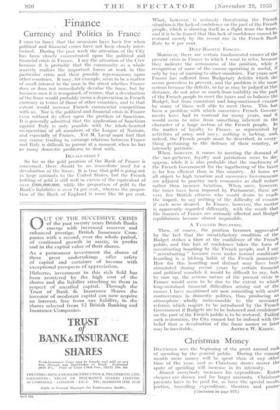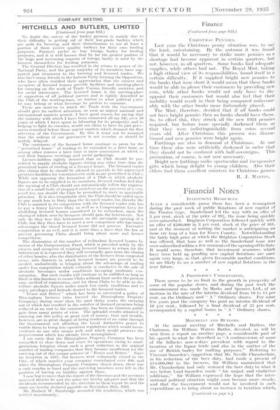Christmas Money
DECEMBER sees the beginning of the great annual rush of spending by the general public. During the cOming month more money will be spent than at any other 'time of the year, and as Christmas draws nearer the spate of spending will increase in its intensity. Almost everybody increases his expenditure. Extra cheques are drawn and for larger amounts. Christmas present's have to be paid for, as have the special meals, parties, travelling expenditure, theatres and panto- nratintczd tin page 923:) •
Finance
(Continued from page 020.)
Mimes. " Share-out clubs " and similar institutions Make large payments to their members. • A clear indication of the amount of extra hard cash required by the public for their Christmas festivities is to be found in the official returns of the Bank of England . issued every Thursday. These returns show the total of notes in circulation and during the next few weeks very large increases will be recorded. Between today and the end of the year something like £30,000,000 extra notes will probably have been put into circulation. The demand for cash is first felt by branch banks throughout the country, which arc called upon to supply the notes for the local shoppers. Additional supplies have then to be obtained from the head offices of the banks in London, which, in turn, arc supplied by the Bank of England.
CHRISTMAS SHOPPING.
• It is not possible, of course, to give an accurate estimate of the amount of additional spending at Christmas time as the millions of extra 'notes issued will change hands many times. • After • Christmas these notes flow back to the banks through the accounts of tradesmen, hotel-keepers and amusement caterers. By the middle of January the circulation will be normal again.
The quantity of notes in circulation is, broadly, taken as an index of the • country's prosperity, as in times of good trade more notes are required for paying wages and for use in the purses of the housewives. It i3 gratifying, therefore, to record that there are sore £22,500,000 more notes in circulation than at this time last year. This is due to the great recovery which has taken place in our industrial and economic position and there is every indication that when the peak of the note circulation is reached at the end of the month, it will be a record in the history of the Bank of England.
To supply the public with its extra notes is a fairly straightforward business. It is true that much addi- tional work is entailed, but the process works smoothly. The public, however, require not only notes, but coin. kis 'here that the trouble occurs.
NEw SILVER.
• Normally, the general public,. although not hesitant to show its disapproval of dirty notes, pays little attention to the coin which it is offered. At Christmas, however, it becomes fastidious. New money is greatly in demand and in some cases is almost insisted upon. The reason is that a Christmas present given in the forM of a bright, gleaming coin seems much more acceptable than one Which is merely a worn piece of silver.
. The supply of new silver varies from year to year. At one time our monetary authorities really entered into the Spirit of Christmas and supplied new coin in almost unlim- ited quantities sufficient to meet all demands. It was found, however, that much more coin was issued than was justified by the currency position. After Christmas the extra coin !lowed back to the banks whose vaults then became crammed with unwanted money.
Today, therefore, the issue of new coin is kept under control, but at the same time efforts' are made to meet reasonable requirements. This year there is quite a good supply of new money. Not in all cases, however, is it dated 1985, as sonic supplies' are taken from stocks which have been struck for a year or two and have not been prevmasly issued. The. ‘supply of new .pennies is more uncertain than that of new silver. Owing to unaccountable changes in Public demand great gluts of copper occur from time to time, and the Mint is obliged to suspend the striking of further supplies until the surplus has been absorbed. Minting of pennies, . for instance, was discontinued in 1922 and was not resumed. until 1926.
A similar position occurred in 1932. The Christmas in that year and in 1933 had no bright pennies.
. . .
(Continued on page 924.) Finance .(Continued from page 923.)
CHB ISTM AS . PENNIES.
Last year the Chris-trims penny situation was, to say the least, entertaining, • By the autumn it was found that it would be necessary to strike more pennies as a shortage had become apparent in certain quarters, but not, however, in all quarters. Some banks had adequate supplies, while others had hot. The Royal Mint, taking a high ethical view of its responsibilities, found itself in a Certain difficulty. If it supplied bright new pennies to the banks that were short it would mean that these banks would be able to please their customers by providing new coin, coin, while other banks would not only have to dis- appoint their customers but would also feel that then. inability would result in their being compared unfavour- ably with the other banks more fortunately placed. The Mint, therefore, decided that if all banks could not have bright pennies then no banks should have them. So, to effect this, they struck all the new 1934 pennies required, but before issue specially darkened them so that they were indistinguishable from coins several years old. After Christmas this process was discon- tinued and new pennies were bright again. Farthings arc also in demand at Christmas. At one time these also were artificially darkened in order that they should not be confused with half-sovereigns. This precaution, of course, is not now necessary. Bright new farthings make spectacular and inexpensive gifts which bring delight to young children. Also their elders find them excellent counters for Christmas games.
• R. J. MARTIN.














































 Previous page
Previous page